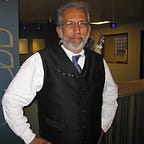Another vanished roadside attraction
The Roy Rogers Museum operated in Victorville from 1967 to 2003
Victorville, California: Fifty years ago the Roy Rogers Museum used to be just about the only reason to stop in this small high desert city between San Bernardino and Barstow on old Route 66.
The museum drew more than 200,000 visitors a year in its heyday. Its main attraction — to resist a dreadful pun — was a dead palomino named Trigger.
Roy Rogers was that pop culture icon unique to mid-twentieth-century America — the singing cowboy. Born Leonard Franklin Slye in 1911, he grew up in Duck Run, Ohio, hoping to become a dentist.
The Great Depression stymied the young man’s plans, and he moved to California in 1930. Len Slye drove trucks, picked peaches, and played guitar for a band called the Sons of the Pioneers. Slye sang on the radio — he’d learned to yodel back home — and auditioned for parts in movies.
He got his big break in 1938 when Republic Studios had a contract dispute with a singing cowboy named Gene Autry. Leonard Slye was no name for a cowpoke, so Republic Studios named him Roy Rogers and gave him the lead role in Under Western Stars.
A cowboy needs a horse. The studio looked at several. Rogers picked a palomino stallion named Golden Cloud. Foaled July 4, 1934, Golden Cloud stood a shade over fifteen hands at the withers. The horse had already made his motion picture debut as Olivia de Havilland’s mount in The Adventures of Robin Hood. He cost $2500 ($42,000 in 2017 dollars). It was money well spent.
Changing the horse’s name to Trigger, Roy Rogers taught his equine friend an impressive array of tricks. As the New York Times noted in Roy’s obituary, Trigger “could untie ropes, sit in a chair, fire a gun and add and subtract.”
Roy Rogers was a big deal in Hollywood in his time. He acted in 91 movies, including My Pal Trigger, Robin Hood of the Pecos, Old Caliente and Pals of the Golden West. He also starred in 102 half-hour television episodes.
Rogers didn’t kill the villains in his movies. He subdued them with his fists, fighting fair by the Marquess of Queensberry rules. And if Roy got punched in the face, you’d see a stylish trickle of blood from the corner of his mouth. He’d draw and fire his six-guns if he had to — shooting the revolver out of a bad guy’s hand — but not if it interfered with his singing.
Roy Rogers met Dale Evans in 1944. Her real name was Frances Octavia Smith, and she’d been born in Uvalde, Texas, in 1912. She’d eloped with a fellow named Tom Fox at fourteen, had a child at fifteen and divorced at seventeen.
Moving to Memphis, Tennessee, Dale worked as a singer to support herself and her young son. Acting gigs followed — she made In Old Oklahoma with John Wayne in 1943 — and she signed with Republic Studios in 1946.
Roy Rogers and Dale Evans married in 1947, and made several pictures together. It was the perfect Hollywood marriage, though the couple never kissed onscreen. When the cameras were rolling, Roy saved his kisses for Trigger.
By now a veteran screen star billed as the smartest horse in the movies, Trigger would appear in 84 films and 101 television episodes. He had his own comic book series.
Trigger retired from show business in 1957, and lived to a ripe old age. When Trigger died July 3, 1965, Roy had him mounted by Bischoff’s Taxidermy and Studio Prop Rental in Burbank, California. Rogers didn’t share the news of Trigger’s death until 1966, and when he did the story made the New York Times.
The Roy Rogers and Dale Evans Museum opened its doors in 1967. Most people came to see Trigger. Also on display were Dale’s horse Buttermilk, and Roy’s German Shepherd, Bullet.
The mounted animals required regular upkeep. Their glass eyes were polished with window spray, and their coats were brushed so parasites wouldn’t damage their hides.
Roy Rogers was a pack rat. He saved everything he had ever endorsed or been given. The 33,000-square-foot museum was crammed with 100,000 items — guns, holsters, mounted game heads and cowboy boots. Plus toys, trinkets, buttons, thimbles, cereal boxes, Christmas creches, comic books, magazines, framed newspaper articles and so on.
And then there were Roy’s vehicles. Roy’s 1963 Pontiac Bonneville convertible — a gift from Nudie Cohn — had steer horns on the front grill, a pair of six-shooters for door handles, and a fancy studded saddle on the transmission hump. Roy Rogers drove it as grand marshal of the 1977 Pasadena Rose Parade.
In addition to Trigger, Buttermilk, Bullet, a pronghorn antelope, a javelina, a mountain goat, six elephant feet and a timber wolf, there was Trigger Junior (1941–1969).
Trigger Junior was a Tennessee Walker stallion whose registered name was Allen’s Gold Zephyr. Roy mostly used him as a body double for the beloved older horse, known as the Old Man on movie sets.
The number of visitors dwindled after Roy Rogers died at 86 in 1998. Dale Evans died at 88 in 2001. Roy and Dale were buried under their real names at Sunset Hills Memorial Park in Apple Valley, California.
Roy Junior, known as Dusty, moved the museum to a 26,000-square-foot facility in Branson, Missouri. Graebel Van Lines used nine eighteen-wheelers for the 1580-mile journey.
The move didn’t work out. Dusty Rogers closed the museum in 2010, and had Christies sell off the contents. The auction fetched $2.9 million, much of which disappeared into the maw of the IRS.
Nellybelle, the 1946 Willys Jeep that was a fixture on the Roy Rogers Show (1951–1957), sold for $116,500. And a Nebraska TV station paid $266,500 for Trigger.
